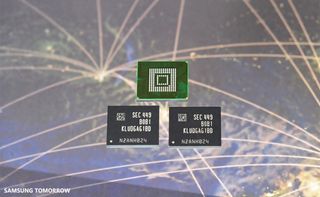Samsung Announces World's First 128 GB Next-Generation UFS Mobile Storage

Samsung announced the introduction of the industry first 128 GB module of UFS storage. UFS, or Universal Flash Storage, which has just reached version 2.0 of the standard, is a next-generation mobile storage technology that's meant to replace the eMMC (embedded multimedia card) standard.
The eMMC standard is now used in many types of consumer electronics, from GPS systems and e-readers to smartphones and tablets. It has recently reached version 5.1, which brings speeds of up to 250 MB/s sequential read, 125 MB/s sequential write, 11,000 IO/s random read, and 13,000 IO/s random write.

The new UFS 2.0 standard seems to pick up where the eMMC standard left off, with speeds that outpace eMMC 5.1 in all areas and compete with lower-end consumer SSDs: 350 MB/s sequential read, 150 MB/s sequential write, 19,000 IO/s random read and 14,000 IO/s random write. Although the eMMC standard has made great progress in random speeds lately, this seems to be the main strength of UFS, which means we can expect it to improve even more in the future.
Samsung is now offering 32 GB, 64 GB and 128 GB UFS modules to its OEM customers, which is double the amount of storage its previous modules had (16 GB, 32 GB and 64 GB). The company expects to increase the sizes even more in the future.
“With our mass production of ultra-fast UFS memory of the industry's highest capacity, we are making a significant contribution to enable a more advanced mobile experience for consumers," said Jee-ho Baek, Senior Vice President of Memory Marketing, Samsung Electronics. “In the future, we will increase the proportion of high-capacity memory solutions, in leading the continued growth of the premium memory market."
With 16-20 MP cameras becoming a trend in high-end and even some mid-range smartphones, 4k video being supported by more and more devices as they ship with newer chips, and apps and games growing in size every year, getting more and also faster storage for the same price will be a welcome improvement.
Although we should begin to see more high-end devices adopt UFS storage in the future, the eMMC standard will continue to live on for a while longer as it becomes a value technology used for lower-end devices. This could also either further decrease the price of those devices or increase their storage.
Stay on the Cutting Edge
Join the experts who read Tom's Hardware for the inside track on enthusiast PC tech news — and have for over 25 years. We'll send breaking news and in-depth reviews of CPUs, GPUs, AI, maker hardware and more straight to your inbox.
Samsung said the UFS technology is ready for the market, so we may see devices begin to arrive with it as soon as this summer or fall. Knowing how Samsung likes to use its own technology first before it sells it to other companies, the first UFS storage module may even appear inside Samsung's own flagship device, the Galaxy S6, this spring.
Follow us @tomshardware, on Facebook and on Google+.
-
josejones What? Is that anything like the new NVMe interface due to come out anytime now?Reply
http://www.tomshardware.com/forum/280390-32-sata-satae/page-2
M.2 and SSD's 20 to 40 Gbps with NVMe
http://hardforum.com/showthread.php?t=1843654 -
jhanschu This is a standard focused mainly for mobile devices. eMMC is also used in hobby computers like the raspberry pi. It's a solid state format, but not anything you'd see in desktops. I've seen it in a few lower end laptops, mainly chromebooks and the like.Reply -
bit_user Lucian, thanks for the table with all the eMMC versions & details and microSD (but does that correspond to SDXC?). I really appreciate the context.Reply
Also, as I understand it, eMMC is simply an electrical interface, meaning there's no standard connector or form factor (in contrast to microSD, for instance). Is the same true of UFS? -
dgingeri I'd love to see something like this embedded on a motherboard for caching or a boot drive (user selectable) as a feature. It's small enough to do it easily enough.Reply -
Steveymoo Now you can record cat pictures and videos even faster than before! Progress!! Seriously though. This is amazing. Look how far technology has advanced in the last decade.Reply -
Sakkura ReplyLucian, thanks for the table with all the eMMC versions & details and microSD (but does that correspond to SDXC?). I really appreciate the context.
MicroSD is a form factor for SD cards. SDXC is an SD card format, which mainly determines the possible storage space. SDXC is the newest format, allowing capacities up to 2TB.
Speed classes are somewhat independent of the format, so you can still get extremely fast SD cards in the lower-capacity SDHC format. The highest speed class cards (UHS-II U3) are only available in the largest form factor, for smaller MicroSD cards the fastest speed class currently available is UHS-I U3, and they top out around 80-100 MB/s read, ~50 MB/s write. The theoretical cap on UHS-I is 104 MB/s, so for faster cards they'll need to move to UHS-II U3, which allows up to 312 MB/s.
Most Popular




